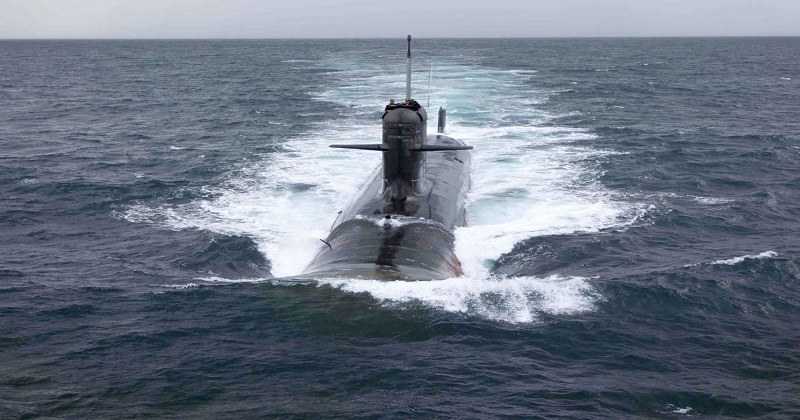
The Defense Ministry cleared a mega project to domestically manufacture six conventional submarines for the Indian Navy at a price of approximately Rs 43,000 crore, in a significant decision proposed to boost India’s naval expertise in the wake of China rapidly developing its maritime skills. The submarines will be built under the much-talked-about strategic partnership model that lets domestic defense manufacturers consolidate with leading foreign defense majors to create high-end military platforms to decrease import dependency.
The Defense Ministry also approved proposals relating to the acquisitions of different military weapons and supplies valued at Rs 6,800 crore. The decisions to approve the naval submarine project called ‘P-75 India’ and the acquisition of the military weapons and equipment were held at a meeting of the Defence Acquisition Council (DAC) chaired by Singh. The DAC is the Defence Ministry’s highest decision-making body on procurement.
The DAC also stretched the timelines for obtaining vital capital acquisitions under the delegated leadership to the armed forces up to August 31, 2021, to allow them to achieve their emergency procurements. “This project envisages indigenous construction of six conventional submarines equipped with the state-of-the-art air-independent propulsion system at an estimated cost of Rs 43,000 crore,” the ministry said about the naval project. “This is a landmark approval, being the first case processed under the strategic partnership model. This would be one of the largest ‘Make in India’ projects and will serve to facilitate faster and more significant absorption of technology and create a tiered industrial ecosystem for submarine construction in India,” it said in a statement. The ministry said the project will help lessen current dependence on imports and gradually assure greater self-reliance and dependability of supplies from domestic origins.

“With accord of this approval, the country will be enabled to achieve its 30-year submarine construction program envisioned by the government to acquire national competence in submarine construction and for the Indian industry to independently design and construct submarines in India,” it said. It said the availability of new technologies and excellent manufacturing skills to the industry will be an essential move towards improving the nation’s search for self-reliance in modern conventional submarine building Under the strategic partnership model, domestic defense manufacturers are permitted to join hands with leading foreign defense areas to create high-end military platforms to decrease import dependence.
Executives said the scheme will be executed in around 12 years and the final cost may go up depending on the weaponry systems to be combined into the stealth submarines. Sources said the DAC authorized the issuance of the Request for Proposal (RFP) or tender to shipbuilder Larsen & Toubro (L&T) and state-owned Mazagaon Docks Ltd (MDL). Both L&T and MDL will have to react to the RFP by joining up with one of the five already short-listed foreign shipyards which are Rosoboronexport (Russia), Daewoo (South Korea), ThyssenKrupp Marine Systems (Germany), Navantia (Spain), and Naval Group (France).
It will be for the L&T and MDL to determine the foreign organization they would like to collude with for the project. The RFP is foreseen to be announced within a month and the agreement will be granted after a comprehensive evaluation of the reply of the L&T and MDL, the experts said. The foundation like specifications of submarines and other crucial necessities for issuance of the RFP for the mega project has been performed by separate units of the Defence Ministry and the Indian Navy. The Indian Navy intends to get 24 new submarines, including six nuclear attack submarines, to support its underwater fighting capability. Presently it has 15 conventional submarines and two nuclear submarines. The Navy has been concentrating on significantly reinforcing its overall skills because of China’s increasing attempts to boost its military presence in the Indian Ocean Region.
The Indian Ocean, recognized as the grounds of the Indian Navy, is crucial to the country’s vital interests. According to global naval examiners, the Chinese navy now has over 50 submarines and about 350 ships. The total number of ships and submarines is extended to go past 500 in the next 8-10 years. The Indian Navy is also in the means of obtaining 57 carrier-borne fighter jets, 111 Naval Utility Helicopters (NUH), and 123 multi-role helicopters under the strategic partnership model. The policy conceives the endowment of long-term vital partnerships with Indian defense majors through an open and aggressive process wherein they would tie-up with global original machine manufacturers (OEMs) to solicit technology transfers. The strategic allies will be chosen in four segments -fighter aircraft, helicopters, submarines, and armored fighting vehicles/main battle vessels. It is anticipated to be extended to other sections. In a couple of years, the government has revealed a set of reform measures and actions to make India a center of defense production.
Read more; Include our culture and history in NCERT books: Students raise demand through Twitter
Last August, the defense minister had declared that India will prevent the import of 101 weapons and military policies like transport aircraft, light combat helicopters, conventional submarines, cruise missiles, and sonar systems by 2024. A second negative list, setting import constraints on 108 military weapons and systems such as next-generation corvettes, airborne early alert systems, tank engines, and radars, was issued this week. In May last, the government declared raising the FDI limit from 49 percent to 74 percent under the automatic way in the defense sector. The Defence Ministry has established a goal of a turnover of Rs 1.75 lakh crore in defense building in the next five years that included an export target of Rs 35,000 crore worth of military hardware.

Post Your Comments